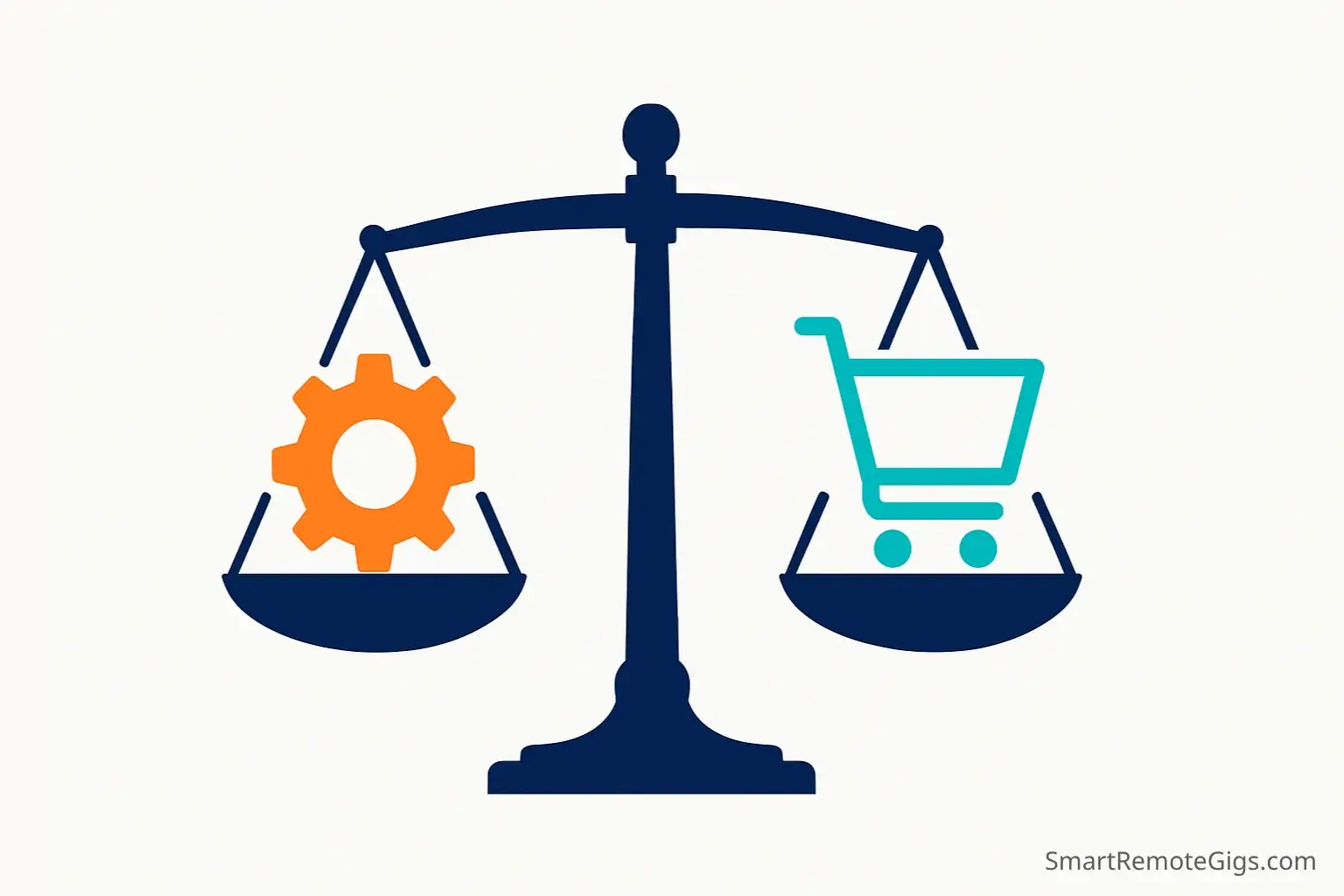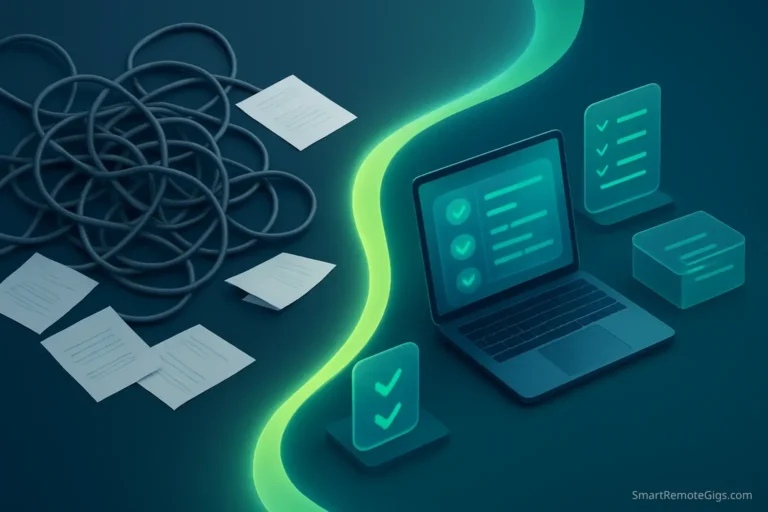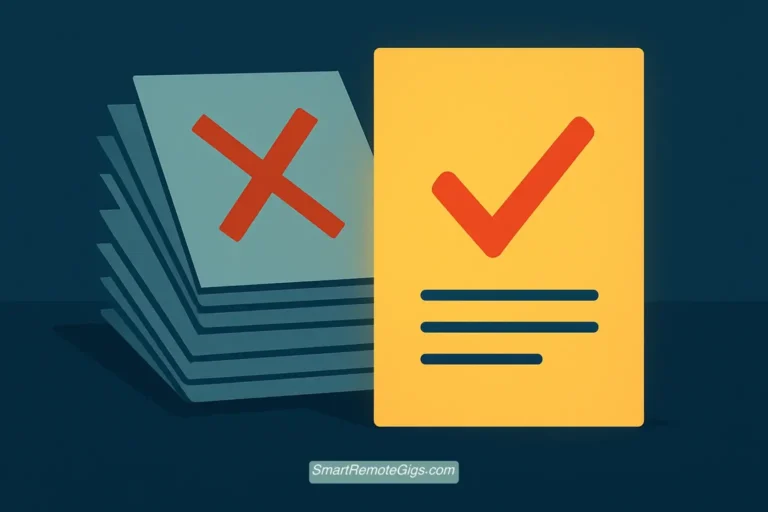Ready to build your portfolio and start earning? Freelance platforms like Upwork and Fiverr are the fastest way to do it. But they work in completely different ways. Choosing the wrong one can be frustrating—you might spend weeks crafting proposals that get ignored, or create services that nobody buys.
Freelance platform scams cost aspiring remote workers thousands of dollars each year, but legitimate platforms like Upwork and Fiverr have helped millions of professionals build successful careers. The key is understanding which platform matches your skills, personality, and goals.
This guide will break down the pros and cons of each platform so you can confidently choose the best one to launch your remote career. By the end, you’ll know exactly which platform suits your working style and provides the fastest path to your first $1,000 in freelance income.
The stakes are significant. Choose correctly, and you’ll start earning within weeks while building valuable experience. Choose incorrectly, and you might struggle for months before realizing the platform doesn’t match your strengths.
Choosing Your First Platform: The Most Important Decision for a New Freelancer
Your choice between Upwork and Fiverr will shape your entire freelance experience. Modern freelance platforms operate on fundamentally different models, and success requires mastering the specific strategies that work on each platform.
💡 Not Sure if Upwork or Fiverr Are Your Only Options? While they are the two biggest platforms for beginners, they aren’t the only ones. If you want to see how they stack up against other options like PeoplePerHour and specialized niche sites, start with our master guide: Choosing a Freelance Website: 2026 Beginner’s Playbook.
Why This Decision Matters
New freelancers often make the critical mistake of trying both platforms simultaneously, spreading their energy thin and mastering neither. Each platform requires different skills, different approaches, and completely different mindsets. The most successful freelancers follow a proven pattern: choose one platform, master it completely, build a steady income stream, then expand to other platforms if desired.
The Success Pattern vs. The Struggle Pattern
Successful freelancers typically:
- Focus on one platform for 90+ days
- Learn platform-specific optimization strategies
- Build momentum with consistent daily effort
- Develop a reputation and loyal client base
- Refine their approach based on real client feedback
Struggling freelancers typically:
- Create profiles on multiple platforms simultaneously
- Use identical approaches across different platforms
- Abandon platforms after a few weeks without results
- Never master the nuances of any single platform
Your Platform Personality Assessment
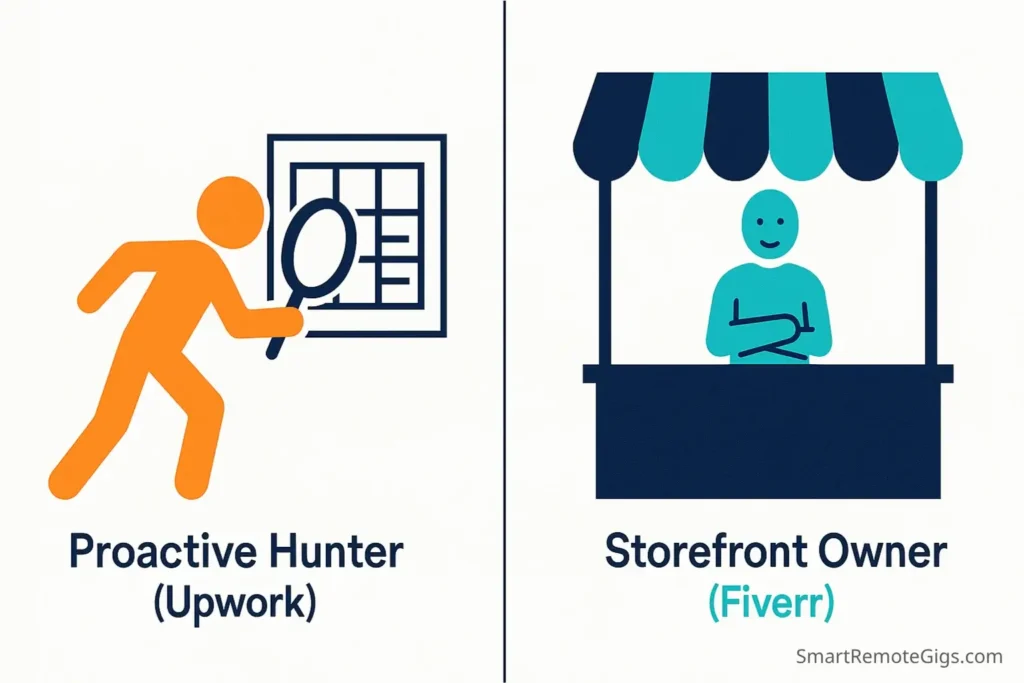
Before diving into features and fees, honestly assess your working style:
- Proactive vs. Reactive: Do you prefer hunting for opportunities or having them come to you?
- Custom vs. Standardized: Do you enjoy solving unique problems or perfecting repeatable processes?
- Sales vs. Marketing: Are you comfortable with direct outreach or do you prefer attracting clients through optimized listings?
Your answers will guide you to the platform where you’ll naturally excel rather than constantly fight against your instincts.
The Core Difference: “I’ll Apply to You” vs. “You’ll Buy From Me”
Understanding this fundamental difference is crucial to your success. Most platform comparisons focus on fees and features, but the real difference lies in who initiates transactions and how work gets discovered.
Upwork: “I’ll Apply to You” (The Job Board Model)
How It Actually Works: Upwork operates like a sophisticated job board where clients post specific projects with detailed requirements. Success depends entirely on your ability to write persuasive proposals that convince clients to choose you over dozens of other applicants.
Your Daily Reality on Upwork:
- Spend 30-60 minutes browsing relevant job postings
- Read project descriptions carefully to identify client pain points
- Write 3-5 custom proposals daily, each tailored to specific requirements
- Follow up strategically on submitted applications
- Compete directly with other freelancers on proposal quality and pricing
The Control vs. Effort Trade-off:
- Maximum Control: You choose exactly which projects to pursue and can tailor your approach to each client’s specific needs
- High Active Effort Required: Success demands consistent daily prospecting, proposal writing, and client communication
Best Upwork Candidates:
- Enjoy reading client problems and crafting custom solutions
- Comfortable with sales-style communication and negotiations
- Prefer variety in projects rather than repetitive tasks
- Have experience that justifies higher hourly rates ($15-$100+)
Fiverr: “You’ll Buy From Me” (The Storefront Model)
How It Actually Works: Fiverr operates like an online marketplace where you create standardized service packages called “Gigs” that clients can purchase directly. Success depends on creating attractive service listings and optimizing them for discoverability.
Your Daily Reality on Fiverr:
- Create detailed Gig descriptions with clear, specific deliverables
- Optimize listings for Fiverr’s search algorithm using relevant keywords
- Respond quickly to client inquiries and custom requests
- Deliver completed work according to your pre-defined packages
- Focus on building reviews and improving search rankings
The Passive vs. Visibility Trade-off:
- More Passive Income Potential: Once optimized Gigs are created, clients discover and purchase your services automatically
- Intense Competition for Visibility: You must compete with thousands of similar services for search placement and client attention
Best Fiverr Candidates:
- Have specific, repeatable skills that package into clear deliverables
- Prefer standardized processes over custom problem-solving
- Comfortable starting with lower prices and scaling up over time
- Enjoy optimizing listings and building passive income streams
Upwork vs. Fiverr: A Head-to-Head Comparison for Beginners
Feature | Upwork | Fiverr |
|---|---|---|
How You Get Work | Write custom proposals for posted jobs | Create optimized “Gigs” and wait for orders |
Best For | Custom, complex projects requiring consultation | Standard, repeatable services with clear deliverables |
Pricing Model | Hourly rates ($3-$200+) or fixed-price projects | Tiered packages (Basic $5+, Standard $25+, Premium $100+) |
Typical Beginner Project Value | $50-$500 initially, $500-$5,000+ with experience | $5-$100 initially, $100-$1,000+ with optimization |
Client Interaction Level | High (interviews, negotiations, ongoing communication) | Medium (order requirements, delivery, revisions) |
Primary Beginner Challenge | Writing compelling proposals that stand out | Creating Gigs that rank well in search results |
Platform Fees | Sliding scale: 20% first $500, 10% next $9,500, 5% after $10K with each client | Flat 20% on all orders plus processing fees |
Payment Protection | Escrow system holds funds until work completion | Automatic payment release upon delivery acceptance |
Essential Success Skill | Proposal writing and client relationship building | SEO optimization and service packaging |
Time to First Sale | 1-4 weeks with targeted proposals | 2-8+ weeks depending on niche competition |
Income Predictability | Highly variable, depends on proposal success rate | More predictable once Gigs gain search visibility |
Learning Curve Difficulty | Moderate to steep (proposal writing, client management) | Moderate (Gig optimization, keyword research) |
Competition Intensity | High but project-specific and time-limited | Very high and ongoing within category rankings |
Ideal for Building Experience | Custom work, client relationships, premium pricing | Standardized services, passive income, volume work |
How to Know if Fiverr is Right for You (The 3-Point Litmus Test)
The Service Test
Can you “productize” your skill into a clear package (e.g., “5 blog post intros,” “3 logo concepts with revisions”)? If yes, Fiverr is a strong fit. Fiverr rewards services that can be clearly defined, consistently delivered, and easily understood by buyers browsing quickly through search results.
The Mindset Test
Do you prefer optimizing a “storefront” and letting clients come to you? If yes, you have the Fiverr mindset. Success on Fiverr comes from creating compelling service listings, optimizing for search visibility, and building a reputation that attracts buyers automatically.
The Income Test
Are you comfortable with a model that starts with smaller, quicker sales to build momentum? If yes, Fiverr’s model will work for you. The platform rewards consistent delivery and positive reviews, with income growing as your search rankings improve and repeat clients return.
Perfect Fiverr Skill Examples:
- Graphic Design: “I will design 3 minimalist logo concepts with unlimited revisions”
- Writing: “I will proofread and edit up to 1,000 words in 24 hours”
- Digital Services: “I will set up a complete WordPress website with your content”
Convinced Fiverr is your launchpad? Your next mission is to turn that decision into income.
Our comprehensive pillar guide, Get Your First Fiverr Client: The Complete Playbook, is your step-by-step roadmap. It covers everything from optimizing your Gig for Fiverr’s algorithm to delivering 5-star service and securing those crucial first reviews.
Need inspiration for what to sell? Use our 10 Profitable Fiverr Gig Ideas for Beginners guide to brainstorm your perfect first Gig before you dive into the playbook.
How to Know if Upwork is Right for You (The 3-Point Litmus Test)
The Service Test
Is your skill consultative and better suited for custom projects (e.g., “marketing strategy development,” “business process optimization”)? If yes, Upwork is designed for you. The platform excels at connecting skilled professionals with clients who need tailored solutions rather than standardized deliverables.
The Mindset Test
Do you enjoy the “hunt”—proactively searching for problems and writing proposals to solve them? If yes, you have the Upwork mindset. Success requires consistently identifying opportunities, crafting compelling proposals, and building relationships through direct communication.
The Income Test
Are you aiming for larger, higher-value contracts from the start, even if it takes longer to land the first one? If yes, Upwork’s model matches your goals. The platform supports premium pricing for skilled professionals who can justify their rates through expertise and results.
Perfect Upwork Skill Examples:
- Virtual Assistant: Administrative task management and research projects
- Content & Marketing: Blog post writing and social media strategy development
- Technical Services: Custom website development and business automation
Ready to master the art of the proposal? Our tactical playbook, How to Get Your First Upwork Job: A No-Experience Guide, gives you the templates and strategies to win.
The Income Reality: What to Expect in Your First 90 Days
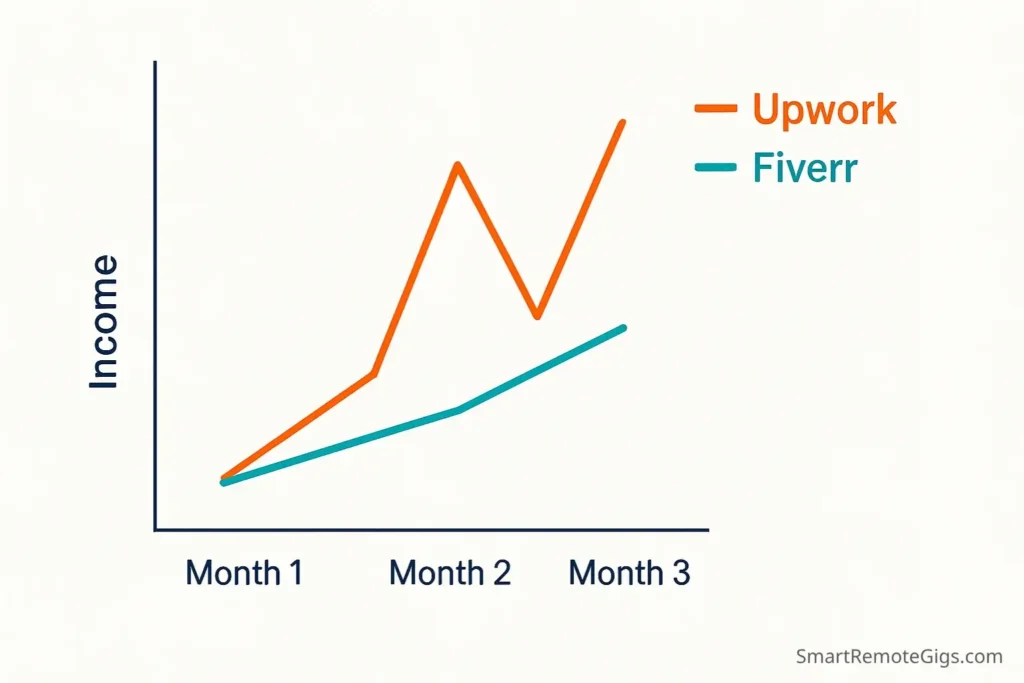
Understanding realistic income expectations prevents frustration and helps you choose the platform that aligns with your financial timeline and goals.
Fiverr Income Progression (Realistic Expectations)
Month 1: $0-$50
- Primary Focus: Creating and optimizing your first 3-5 Gigs
- Learning Curve: Understanding Fiverr’s interface, policies, and search system
- First Orders: Often come from personal network or friends supporting your launch
- Key Milestone: Getting your first genuine review from a satisfied client
Month 2: $50-$200
- Organic Discovery: Gigs begin appearing in relevant search results
- Algorithm Boost: Positive reviews help improve search ranking
- Service Refinement: You adjust offerings based on client feedback and requests
- Expansion Strategy: Add complementary Gigs in related service areas
Month 3: $150-$500
- Established Presence: Multiple Gigs with consistent positive reviews
- Regular Client Base: Mix of new discovery and repeat customers
- Search Ranking: Well-optimized Gigs consistently appear in top results
- Premium Pricing: Confidence to increase prices based on demand and reviews
Upwork Income Progression (Realistic Expectations)
Month 1: $0-$100
- Primary Focus: Learning to write effective, targeted proposals
- Market Research: Understanding client needs and competitive pricing in your niche
- Initial Challenges: Low proposal success rate while learning platform dynamics
- First Projects: Usually smaller, lower-paying jobs to build initial reviews
Month 2: $100-$400
- Improved Success Rate: Better understanding of what clients want to hear
- Relationship Building: First satisfied clients become repeat customers
- Niche Focus: Identifying specific project types where you excel
- Confidence Growth: Willingness to bid on larger, better-paying projects
Month 3: $300-$800
- Strong Profile: Multiple positive reviews and JSS (Job Success Score) above 85%
- Premium Positioning: Confidence to charge higher rates based on proven results
- Client Relationships: Regular work from 2-3 satisfied clients
- Efficient Prospecting: Better targeting reduces proposal writing time
Critical Difference in Income Patterns
Fiverr: More predictable income growth once Gigs gain traction, but typically starts lower and grows steadily. Success depends on search optimization and service standardization.
Upwork: More variable income with higher potential early spikes, but requires consistent proposal effort. Success depends on relationship building and premium positioning.
What Success Looks Like on Each Platform
What Success Looks Like on Fiverr
- Focuses on Gig ranking and review velocity – Optimizes listings for search visibility and prioritizes quick, positive feedback
- Masters the art of the upsell through packages – Creates tiered service offerings that guide clients to higher-value purchases
- Builds passive income through search optimization – Develops systems where clients discover and purchase services automatically
- Scales through service standardization – Creates repeatable processes that maintain quality while increasing volume
What Success Looks Like on Upwork
- Focuses on high proposal win-rate – Develops expertise in writing compelling, targeted proposals that convert
- Builds long-term client relationships for recurring revenue – Prioritizes client satisfaction to generate repeat business and referrals
- Commands premium pricing through expertise positioning – Establishes authority in specific niches to justify higher rates
- Develops consultative sales skills – Masters the art of understanding client needs and presenting tailored solutions
The Platform Switching Decision: When and How to Expand
Many successful freelancers eventually use multiple platforms, but timing and strategy determine whether expansion accelerates or undermines your income growth.
When to Consider Adding a Second Platform
Green Light Indicators (Ready to Expand):
- Consistent $1,000+ monthly income from your primary platform for 3+ months
- Mastered your current platform’s systems and optimization strategies
- Built a reliable client base that provides recurring work
- Have additional time capacity without sacrificing current client quality
- Identified complementary opportunities that don’t exist on your current platform
Red Light Indicators (Stay Focused):
- Monthly income still fluctuates significantly on your primary platform
- Still learning platform-specific optimization strategies
- Client relationships are new and require active nurturing
- Already working at full capacity with current clients
- Haven’t yet found your most profitable service offerings
Strategic Platform Expansion Approaches
The Complementary Services Strategy: Use different platforms for different types of work rather than competing with yourself:
- Upwork: High-value, custom consulting and long-term projects
- Fiverr: Standardized, quick-turnaround services and overflow work
The Client Funnel Strategy: Use one platform to attract clients and another to deliver ongoing services:
- Fiverr: Attract clients with low-cost initial services
- Direct Relationship: Move satisfied clients to direct contracts for larger projects
The Diversification Strategy: Reduce platform dependency by building presence across multiple channels:
- Primary Platform: 60% of income and effort
- Secondary Platform: 25% of income and effort
- Direct Clients: 15% of income through referrals and networking
Beyond Platforms: Building Long-Term Freelance Success
While choosing between Upwork and Fiverr is important for immediate income, the most successful freelancers eventually build systems that reduce platform dependency.
The Platform Independence Timeline
Phase 1 (Months 1-6): Platform Mastery
- Focus exclusively on mastering your chosen platform
- Build strong reviews and client relationships
- Develop efficient systems for your most profitable services
- Achieve consistent $1,500+ monthly income
Phase 2 (Months 6-12): Client Relationship Development
- Transition best platform clients to direct relationships
- Develop retainer agreements for recurring work
- Create systems for managing clients outside platform constraints
- Build portfolio of case studies and testimonials
Phase 3 (Months 12-24): Business Expansion
- Add complementary platforms or service offerings
- Develop referral systems from satisfied clients
- Create passive income products (courses, templates, tools)
- Consider subcontracting or team building for larger projects
Essential Business Systems for Freelance Growth
Client Communication Systems:
- Professional email address and signature
- Standardized project proposal templates
- Clear contract templates for direct work
- Efficient project management and communication tools
Financial Management Systems:
- Separate business banking accounts
- Invoice tracking and payment processing
- Tax preparation and quarterly payment systems
- Profit tracking and business expense management
Marketing and Lead Generation:
- Professional website showcasing your best work
- LinkedIn presence optimized for your target clients
- Case study library demonstrating measurable results
- Referral system incentivizing client recommendations
Decision Mandate: Your Path to Freelance Success Starts Today
You have the data. You understand the psychology. You know the income potential. Now, make a decision.
The most critical factor in your freelance success isn’t which platform you choose—it’s how quickly you start and how consistently you execute.
The Decision Paralysis Reality
Every day spent researching platforms is a day not spent building your freelance career. Both Upwork and Fiverr have created thousands of successful freelancers. Both platforms have also disappointed freelancers who expected instant success without strategic effort.
Your Success Formula
- Choose based on honest self-assessment: If you’re consultative and enjoy custom work, start with Upwork. If you prefer standardized services and passive discovery, master Fiverr.
- Commit to 90-day mastery: Give your chosen platform three full months of consistent, strategic effort before evaluating results or considering alternatives.
- Track meaningful metrics: Monitor proposal success rates on Upwork or search rankings on Fiverr. Use data, not assumptions, to optimize your approach.
- Focus on client satisfaction: Both platforms reward freelancers who consistently deliver exceptional results. Your reviews and ratings determine long-term success.
The Action-Taker’s Advantage
While others spend weeks comparing platforms, action-takers are already earning their first $500. The freelance platforms that succeed are filled with professionals who started before they felt completely ready and learned through real client interactions.
Your Next Steps
If you chose Upwork: Create your profile today, write your first proposal tonight, and commit to submitting 5 proposals daily for the next 30 days.
If you chose Fiverr: Set up your first Gig this week, optimize it based on competitor research, and create 2 additional complementary Gigs within 30 days.
Either platform: Document your progress, learn from every interaction, and adjust your strategy based on real client feedback rather than theoretical concerns.
The Bottom Line Truth
Perfect platform choice is less important than consistent execution on whichever platform you select. You can always switch later, but you can’t earn money from platforms you never join or services you never create.
The only wrong choice is not making one.
Stop researching. Start earning. Your freelance career begins with the first profile you complete, not the perfect platform you eventually discover.
🚀 Ready to Launch Your Complete Remote Career? This freelance platform guide is just one piece of your remote work strategy. Return to our comprehensive Remote Jobs No Experience: Your Definitive 2026 Guide for the complete roadmap to legitimate work-from-home opportunities. For role-specific guidance, explore our detailed career guides for Virtual Assistant Jobs.
Upwork vs. Fiverr: Which Freelance Platform Is Best for Beginners?
Upwork
The professional's choice. Upwork operates like a sophisticated job board where you write custom proposals for a wide range of complex, long-term projects.
Best for freelancers with a consultative work style who enjoy writing custom proposals and building long-term, high-value client relationships.
Editor's Rating:
Price: Free
Visit WebsiteFiverr
The gig economy champion. Fiverr operates like an online marketplace where you create standardized service packages ('Gigs') that clients purchase directly.
Best for freelancers who prefer to 'productize' their services into clear packages and build a passive income stream through search optimization.
Editor's Rating:
Price: Free
Visit Website
